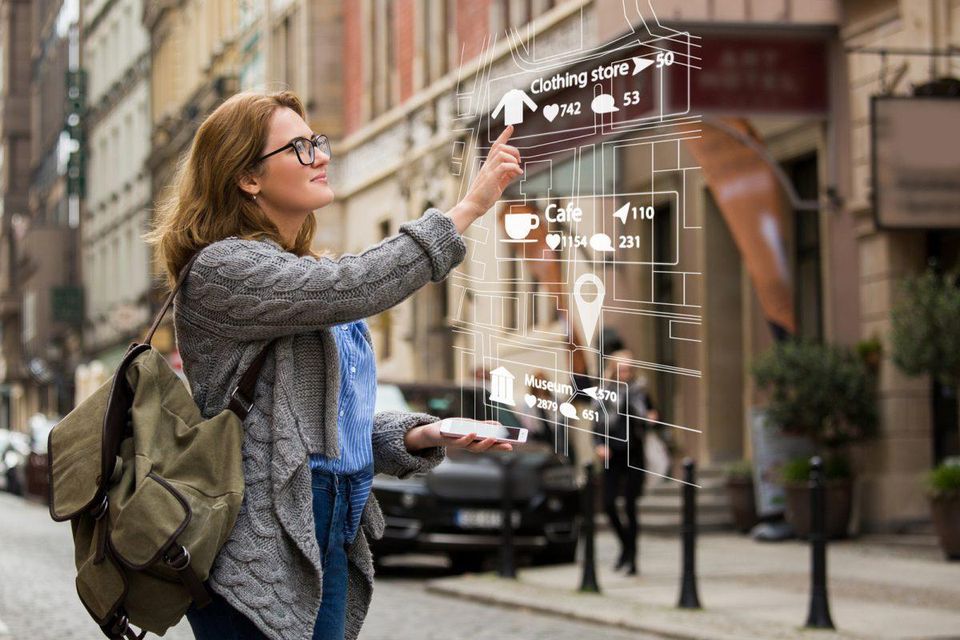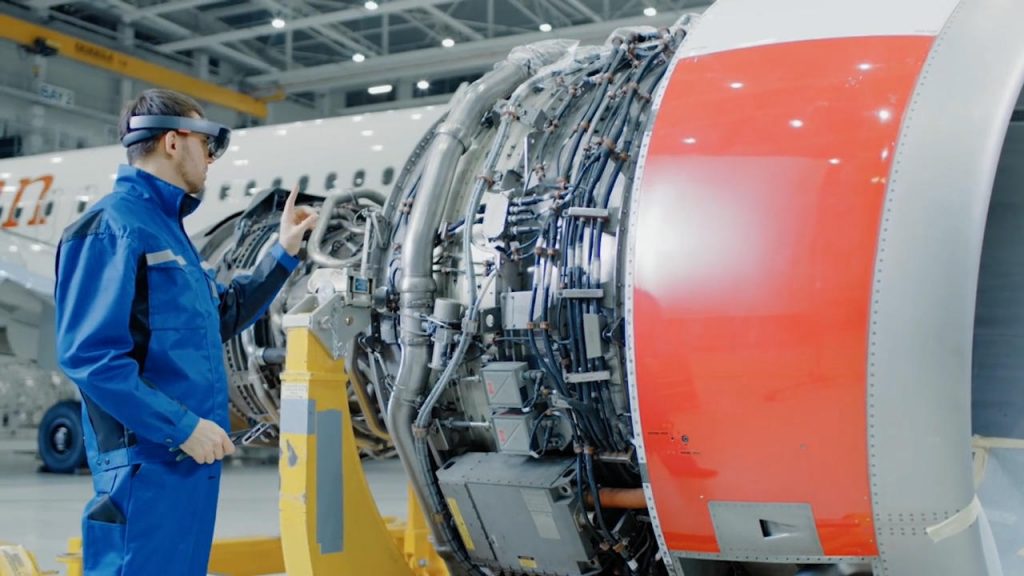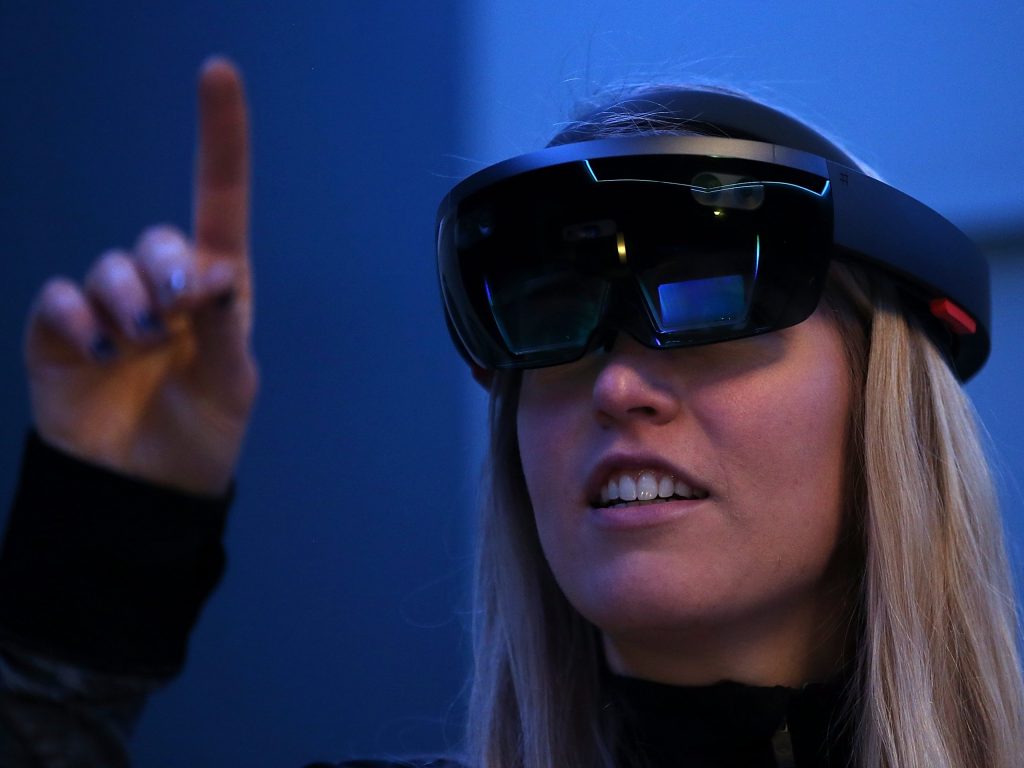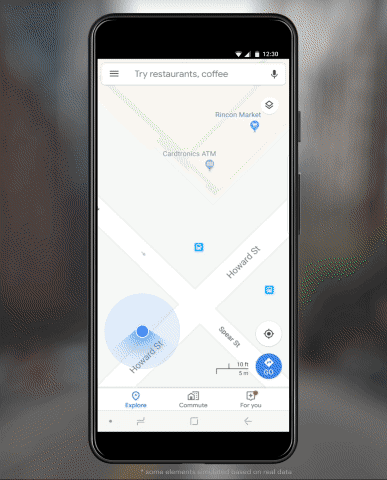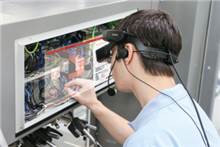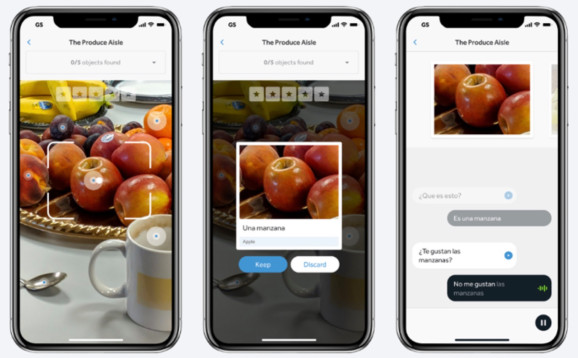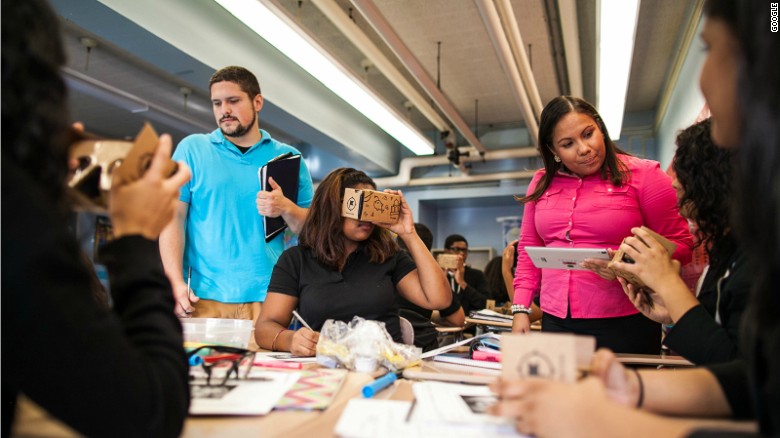We’ve been working on this for a long time. Introducing AR wayfinding, by Dent Reality. pic.twitter.com/XHZ2ipvZDO
— Andrew Hart (@AndrewProjDent) April 11, 2019
Augmented Reality: The Future of Medicine — from interestingengineering.com by Susan Fourtané
Augmented Reality can change brain surgery thanks to powerful diagnostic platforms, revolutionize radiology, and open new doors to reconstructive surgery.
Excerpt:
Augmented Reality (AR), also known as spatial computing — a merging of digital and physical spaces — is one of the current technology trends that, together with Virtual Reality (VR) and Mixed Reality (MR), is changing all industries, including healthcare and medical education.
Skills gap? Augmented reality can beam in expertise across the enterprise — from by Greg Nichols
Hives of subject matter experts could man augmented reality switchboards, transferring knowledge to field.
Excerpt:
Some 10 million manufacturing jobs will likely be needed in the coming decade, yet many of those will likely go unfilled, according to Deloitte and the Manufacturing Institute. Somewhat ironically, one of the biggest factors holding back a strong American manufacturing segment in 2019 may not be cheap foreign labor but unqualified U.S. labor.
Augmented reality, which is still trying to find its stride in the enterprise, could help by serving as a conduit for on-the-job knowledge transfer.
“We are excited to offer industrial enterprises a new way to use AR to leverage the tribal knowledge of subject matter experts (SMEs) and help alleviate the skills gap crisis threatening today’s industrial enterprise,” says Mike Campbell, EVP, augmented reality products, PTC.
Five key trends for professional and continuing education leaders in the next five years [Schroeder]
Five key trends for professional and continuing education leaders in the next five years — from evolllution.com by Ray Schroeder
Excerpts:
Higher education is on the cusp of major changes. Enrollments are on the decline—both online and on campus—and the trend is expected to accelerate.[1] Graduates are laboring under substantial college loan debts totaling more than $1.5 trillion.[2] Employers are demanding that applicants possess soft and hard skills that many college graduates do not hold.[3] At the same time new and emerging technologies are changing the way credentials are shared and work is done.
It is in this context that continuing, professional and online programs have been imported from the periphery to the center of traditional universities. Students and employers alike have made clear that their top priority is relevance to the rapidly changing workplace. Artificial intelligence, blockchain, augmented/virtual reality and other technologies are driving the changes. Professional and Continuing Education (PCE) has long been the leader in providing relevant courses, certificates and degrees that connect students with the needs of employers.
…the Online Master’s Science in Computer Science degree at Georgia Tech is now the largest computer science program in the world. And the degree costs less than $9,000.
Also see:
Interview with Hunt Lambert – What is the 60-year curriculum?
Colleges and universities used to be primarily responsible for a four-year learning experience. We now need to envision a 60-year curriculum, whereby educational institutions partner with learners at all stages of their professional career, providing skills and knowledge as needed.

Mirrorworld v. AR Cloud or: How I learned to stop worrying and love the spatial future — from medium.com by Ori Inbar
Excerpts (emphasis DSC):
An exact digital replica of the real world is an essential infrastructure, but it’s only part of the meaning of the new spatial computing platform. Unless you are Snow White’s step mother (or Lord Farquaad), the mirror is merely a reflection of the real world; it doesn’t enhance it. The Augmented content overlaid on top of the world’s digital replica is what’s really interesting: “context, meaning, and function” in Kelly’s words. Without it — it’s like the Internet before the Web — great potential, used by few. Hence my initial instinct to include Augmented Reality in the moniker. So should we keep looking for a better term that captures the “augmented” sauce on top of the mirror ? Can’t we simply settle on “Spatial Computing”…?
…
Ask any millennial and she’ll confirm: “I need info about what’s in front of me right now” — what’s this Restaurant, this object, that person? And she is sick of searching it the old fashioned way.
…
The New Spatial Economy
Changing how information is organized will profoundly disrupt the Web economy. A handful of companies became giants thanks to the current model. No wonder they are all contenders in the battle for AR Cloud dominance. The Web Economy was defined by “clicks on links” (CPM/CPC). The AR Cloud-based spatial economy will transition to what I like to call “clicks on bricks” — a punning rhyme that captures a new world where everything is driven by digital interaction with the physical world.
From DSC:
Hmmm….where everything is driven by digital interaction with the physical world.
Augmented Reality is the operations system of the future. AR cloud is how we get there. — from forbes.com by John Koetsier
Excerpt:
In the future, every object will be smart.
Not necessarily because everything will be made of “smart matter,” with chips, motors, sensors, and radios (although this is happening). But increasingly because we are starting to digitally paint over default reality, layering on data, insights, and entertainment in virtual or augmented layers. When we shift from smartphones to smartglasses over the next decade, this will only accelerate.
From games to street directions to metadata, from industrial heads-up displays to virtual gamescapes to workspace information, these new augmented, virtual, and extended realities will be aware, data-rich, contextual, and interactive.
But there is a core enabling technology required.
And I’m not just talking about smartglasses hardware with great functionality, good usability, and a reasonable price, which are probably at least three to five years away.
I’m talking about the augmented reality cloud.
Also relevant/see:
- Microsoft releases new apps that make augmented reality way more helpful to businesses — from businessinsider.com by Rosalie Chan
DC: I agree that we neeed those smart glasses to free up our hands. For example, if #AR was a tool used by technical communicators to show us how to put a piece of furniture together, we need our hands free to do so.https://t.co/yKU0q7yUkv
— Daniel Christian (@dchristian5) February 16, 2019
AR will spark the next big tech platform — call it Mirrorworld — from wired.com by Kevin Kelly
Excerpt:
It is already under construction. Deep in the research labs of tech companies around the world, scientists and engineers are racing to construct virtual places that overlay actual places. Crucially, these emerging digital landscapes will feel real; they’ll exhibit what landscape architects call placeness. The Street View images in Google Maps are just facades, flat images hinged together. But in the mirrorworld, a virtual building will have volume, a virtual chair will exhibit chairness, and a virtual street will have layers of textures, gaps, and intrusions that all convey a sense of “street.”
The mirrorworld—a term first popularized by Yale computer scientist David Gelernter—will reflect not just what something looks like but its context, meaning, and function. We will interact with it, manipulate it, and experience it like we do the real world.
Also see:
Google Maps in augmented reality points you in the right direction — from mashable.com by Sasha Lekach
Bobst launches augmented reality helpline — from proprint.com.au by Sheree Young
Excerpt:
Swiss packaging and label equipment supplier Bobst has launched a new augmented reality smart headset to help answer customer questions.
Rapid problem solving thanks to a new augmented reality helpline service introduced by Swiss packaging and label equipment supplier Bobst stands to save printers time and money, the company says.
The Helpline Plus AR innovation provides a remote assistance service to Bobst’s customers using a smart headset with augmented reality glasses. The technology is being gradually rolled out globally, Bobst says.
Customers can use the headset to contact technical experts and iron out any issues they may be having as well as receive real time advice and support.
How Museums are using Augmented Reality — from museumnext.com by Charlotte Coates
Excerpt:
How can museums use augmented reality?
There are many possibilities for the use of AR in museums. The most straightforward way is to use it to add explanations of pieces. This means visitors will get more information when they view exhibitions using AR. Museums could even use it to display digital versions of artists next to their work. These 3D personas are then able to provide a narration. AR gives an opportunity to add a third dimension to displays, bringing objects or scenes to life. There are already many institutions around the world using AR. These projects bring something new to existing collections and attract wider audiences. Here are some interesting ways that museums are using augmented reality.
What is 5G? Everything you need to know — from techradar.com by Mike Moore
The latest news, views and developments in the exciting world of 5G networks.
Excerpt:
What is 5G?
5G networks are the next generation of mobile internet connectivity, offering faster speeds and more reliable connections on smartphones and other devices than ever before.
Combining cutting-edge network technology and the very latest research, 5G should offer connections that are multitudes faster than current connections, with average download speeds of around 1GBps expected to soon be the norm.
The networks will help power a huge rise in Internet of Things technology, providing the infrastructure needed to carry huge amounts of data, allowing for a smarter and more connected world.
With development well underway, 5G networks are expected to launch across the world by 2020, working alongside existing 3G and 4G technology to provide speedier connections that stay online no matter where you are.
So with only a matter of months to go until 5G networks are set to go live, here’s our run-down of all the latest news and updates.
From DSC:
I wonder…
- What will Human Computer Interaction (HCI) look like when ~1GBps average download speeds are the norm?
- What will the Internet of Things (IoT) turn into (for better or for worse)?
- How will Machine-to-Machine (M2M) Communications be impacted?
- What will that kind of bandwidth mean for XR-related technologies (AR VR MR)?
FDA approves HoloLens powered medical augmented reality system — from by Richard Devine
HoloLens might be about to make surgical procedures a whole lot different.
Excerpt:
From Healthimaging.com
OpenSight specifically utilizes the Microsoft HoloLens headset that allows simultaneous visualization of the 3D patient images in AR and the actual patient and their real-world surroundings. The technique may decrease operative times and improve surgical planning and the understanding of anatomic relationships.
Can virtual reality revolutionize education? — from cnn.com by Emma Kennedy
“Kids love to engage with [VR] lessons,” said Guido Kovalskys, chief executive and co-founder of US-based edtech company Nearpod. “One minute, they are learning about Roman history, and the next, they are transported to ancient Rome and are exploring the Colosseum.”
From DSC:
Ok, so the title is on the overhyped side, but I do think XR will positively impact learning, understanding.
University of Washington Researchers Demo Ability to Generate 3D Augmented Reality Content from 2D Images — from next.reality.news by Tommy Palladino
Age of Sail: Setting the course for virtual reality narratives in the future — from by Jose Antunes
The most ambitious project from Google Spotlight Stories is also the one that pushes the boundaries in terms of the creation of narratives in Virtual Reality: embark on Age of Sail.
Augmented Reality Remote Collaboration with Dense Reconstruction
Addendum:
- VR & AR 2018: A year in review — from vrscout.com by Kyle Melnick
Excerpt:
If 2016 was the birth of modern VR/AR technology, than 2018 was its elementary school graduation. While this past year may have seemed like a quiet one when compared to the more exciting releases featured in 2017 and 2016, these past 12 months have been crucial in the development of the immersive entertainment sector.Major hardware releases, vast improvements to software, and various other integral advancements have quietly solidified VR & AR as viable, long-term technological platforms for years to come. So while there may not have been any bombshell announcements or jaw-dropping reveals per sey, 2018 will still go down as a key, if not climactic, year for VR & AR technology regardless.
With a new year full of exciting possibilities ahead of us, let’s hang back a second and take a look back at 2018’s most pivotal moments.
The promises/possibilities — and yet the pitfalls/issues — regarding various XR-related technologies
On one hand XR-related technologies
show some promise and possibilities…
The AR Cloud will infuse meaning into every object in the real world — from venturebeat.com by Amir Bozorgzadeh
Excerpt:
Indeed, if you haven’t yet heard of the “AR Cloud”, it’s time to take serious notice. The term was coined by Ori Inbar, an AR entrepreneur and investor who founded AWE. It is, in his words, “a persistent 3D digital copy of the real world to enable sharing of AR experiences across multiple users and devices.”
Augmented reality invades the conference room — from zdnet.com by Ross Rubin
Spatial extends the core functionality of video and screen sharing apps to a new frontier.
The 5 most innovative augmented reality products of 2018 — from next.reality.news by Adario Strange
Augmented, virtual reality major opens at Shenandoah U. next fall — from edscoop.com by by Betsy Foresman
Excerpt:
“It’s not about how virtual reality functions. It’s about, ‘How does history function in virtual reality? How does biology function in virtual reality? How does psychology function with these new tools?’” he said.
The school hopes to prepare student for careers in a field with a market size projected to grow to $209.2 billion by 2022, according to Statista. Still at its advent, Whelan compared VR technology to the introduction of the personal computer.
VR is leading us into the next generation of sports media — from venturebeat.com by Mateusz Przepiorkowski
Accredited surgery instruction now available in VR — from zdnet.com by Greg Nichols
The medical establishment has embraced VR training as a cost-effective, immersive alternative to classroom time.
Toyota is using Microsoft’s HoloLens to build cars faster — from cnn.comby Rachel Metz
From DSC:
But even in that posting the message is mixed…some pros…some cons. Some things going well for XR-related techs…but for other things, things are not going very well.
…but on the other hand,
some things don’t look so good…
Is the Current Generation of VR Already Dead? — from medium.com by Andreas Goeldi
Excerpt:
Four years later, things are starting to look decidedly bleak. Yes, there are about 5 million Gear VR units and 3 million Sony Playstation VR headsets in market, plus probably a few hundred thousand higher-end Oculus and HTC Vive systems. Yes, VR is still being demonstrated at countless conferences and events, and big corporations that want to seem innovative love to invest in a VR app or two. Yes, Facebook just cracked an important low-end price point with its $200 Oculus Go headset, theoretically making VR affordable for mainstream consumers. Plus, there’s even more hype about Augmented Reality, which in a way could be a gateway drug to VR.
But it’s hard to ignore a growing feeling that VR is not developing as the industry hoped it would. So is that it again, we’ve seen this movie before, let’s all wrap it up and wait for the next wave of VR to come along about five years from now?
There are a few signs that are really worrying…
From DSC:
My take is that it’s too early to tell. We need to give things more time.









